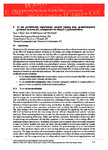In situ perturbation experiments: natural venting sites, spatial/temporal gradients in ocean pH, manipulative in situ pCO2 perturbations
| dc.contributor.author | Barry, JP | |
| dc.contributor.author | Hall-Spencer, Jason | |
| dc.contributor.author | Tyrell, T | |
| dc.contributor.editor | Riebesell U | |
| dc.contributor.editor | Fabry VJ | |
| dc.contributor.editor | Hansson L | |
| dc.contributor.editor | Gattuso J-P | |
| dc.date.accessioned | 2013-02-19T16:20:45Z | |
| dc.date.available | 2013-02-19T16:20:45Z | |
| dc.date.issued | 2010-02-01 | |
| dc.identifier.isbn | 978-92-79-11118-1 | |
| dc.identifier.other | 8 | |
| dc.identifier.uri | http://hdl.handle.net/10026.1/1315 | |
| dc.description.abstract |
Introduction. The objectives of in situ experiments studying ocean acidifi cation vary widely, with most recent studies centering on the effects of changing carbonate chemistry on the biology and ecology of organisms and ecosystems. The advantages of in situ observations are that they offer a completely independent approach to laboratory experiments, one that is based on looking directly at how organisms and communities and ecosystems react to high/low pH and saturation state (Ω) in the real world, replete with all its biodiversity, ecosystem interactions and adaptation to the ambient chemistry. Studies have included measurements of faunal patterns, calcification, dissolution, growth, survival, metabolic rate, physiological responses, behaviour, community interactions, and other processes, in relation to spatial and/or temporal changes in pH, p(CO2 ), or aragonite and calcite saturation states. Here, we focus principally on the approach and methods of in situ experimental studies, using examples of recent work and developing techniques. Two major types of in situ experiments are used for ocean acidification research including: − In situ observational studies that compare patterns or processes between areas that differ naturally in seawater acidity and/or carbonate saturation states. − In situ perturbation experiments, where researchers manipulate conditions to compare patterns or processes between artificially acidified and control conditions. | |
| dc.format.extent | 123-136 | |
| dc.language.iso | en | |
| dc.relation.ispartof | Guide to Best Practices in Ocean Acidification Research and Data Reporting | |
| dc.title | In situ perturbation experiments: natural venting sites, spatial/temporal gradients in ocean pH, manipulative in situ pCO2 perturbations | |
| dc.type | chapter | |
| plymouth.organisational-group | /Plymouth | |
| plymouth.organisational-group | /Plymouth/Faculty of Science and Engineering | |
| plymouth.organisational-group | /Plymouth/PRIMaRE Publications | |
| plymouth.organisational-group | /Plymouth/REF 2021 Researchers by UoA | |
| plymouth.organisational-group | /Plymouth/REF 2021 Researchers by UoA/UoA07 Earth Systems and Environmental Sciences | |
| plymouth.organisational-group | /Plymouth/Research Groups | |
| plymouth.organisational-group | /Plymouth/Research Groups/Marine Institute | |
| plymouth.organisational-group | /Plymouth/Users by role | |
| plymouth.organisational-group | /Plymouth/Users by role/Academics | |
| dc.publisher.place | Luxenbourg | |
| dc.rights.embargoperiod | Not known | |
| rioxxterms.licenseref.uri | http://www.rioxx.net/licenses/all-rights-reserved | |
| rioxxterms.type | Book chapter |


